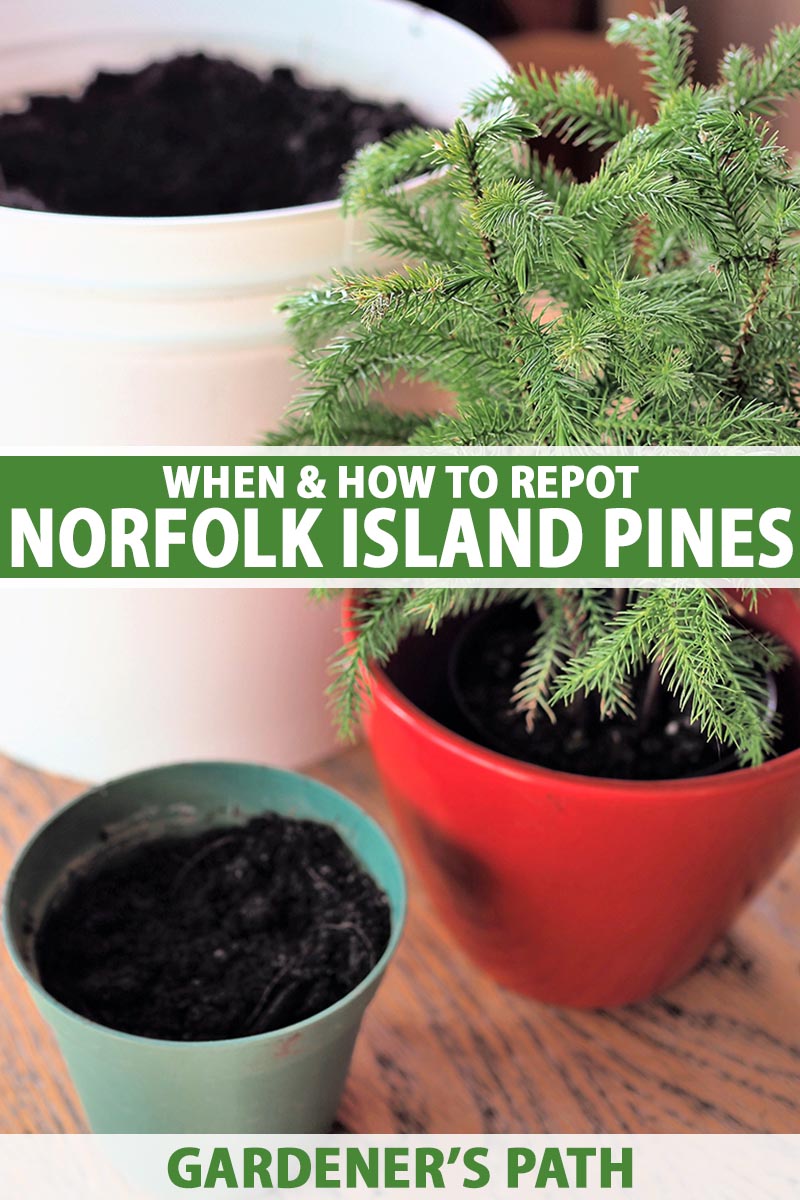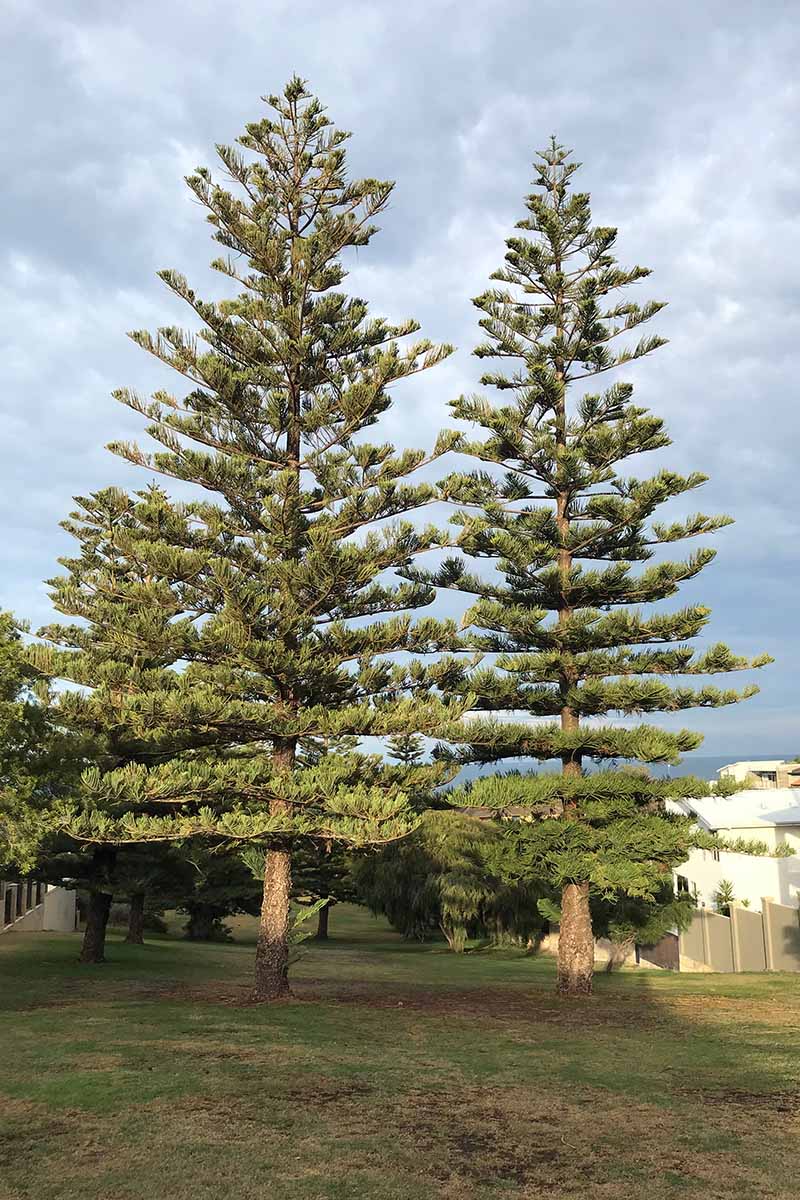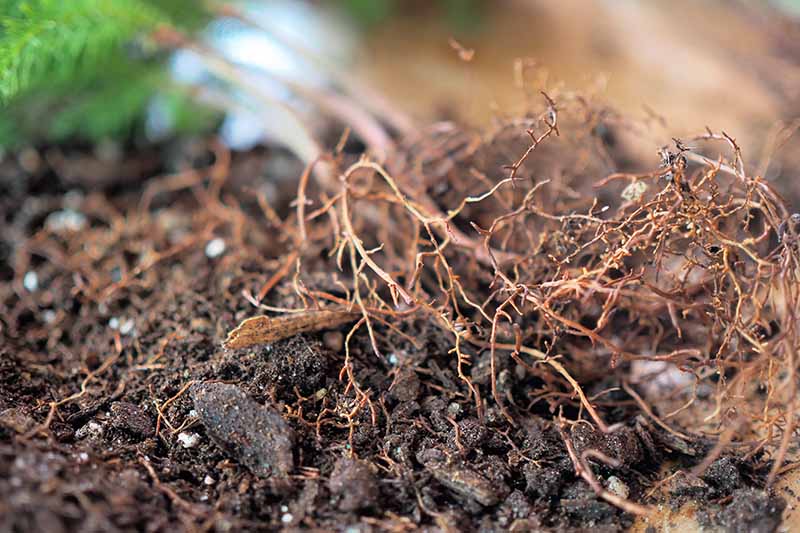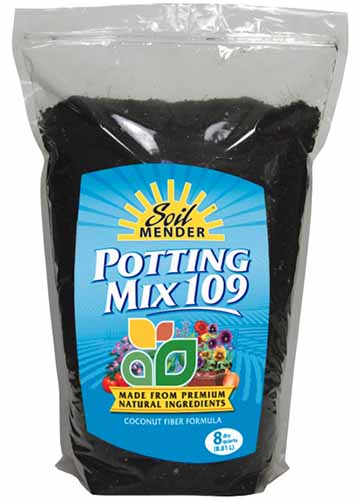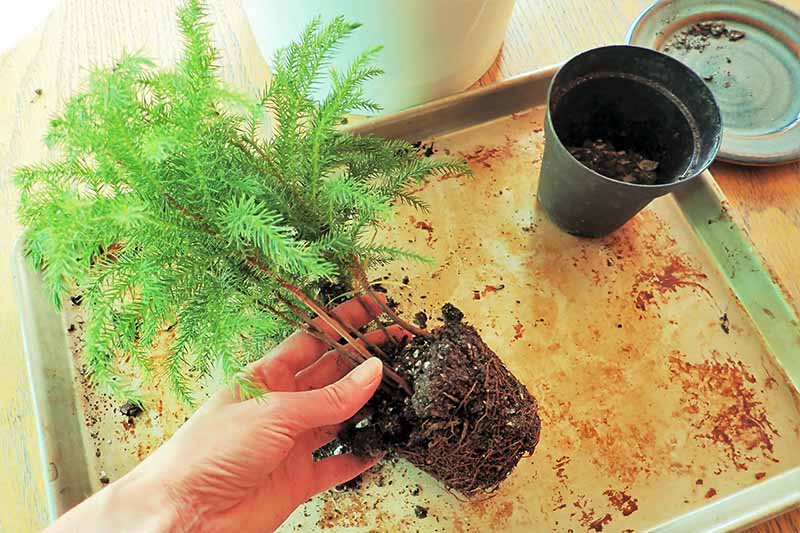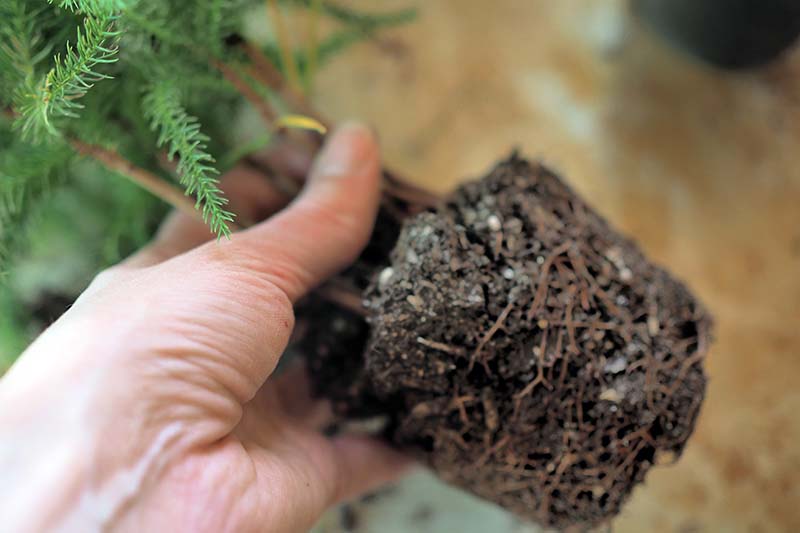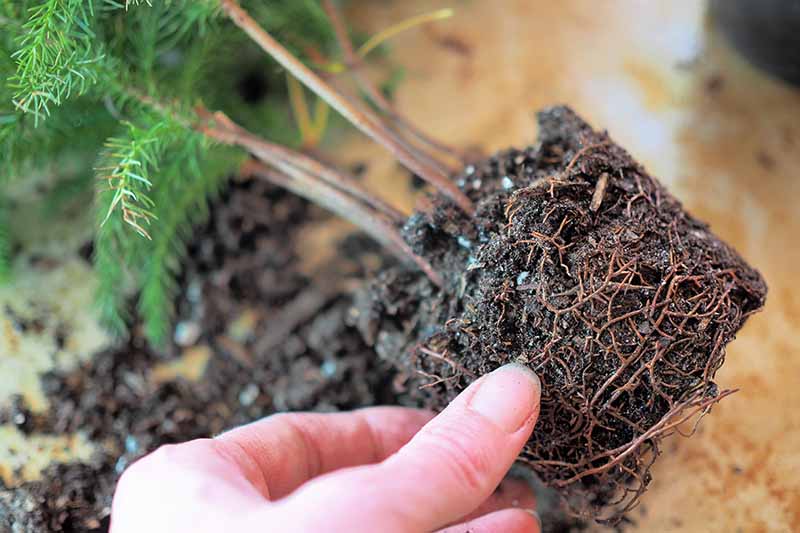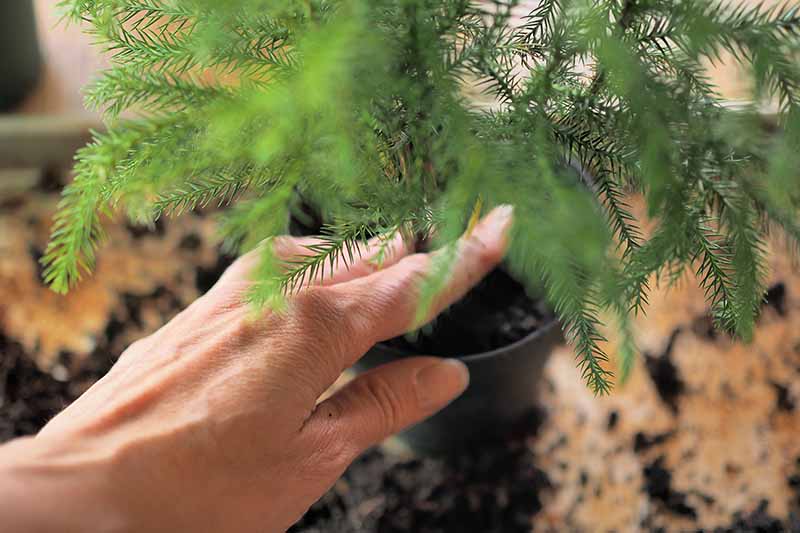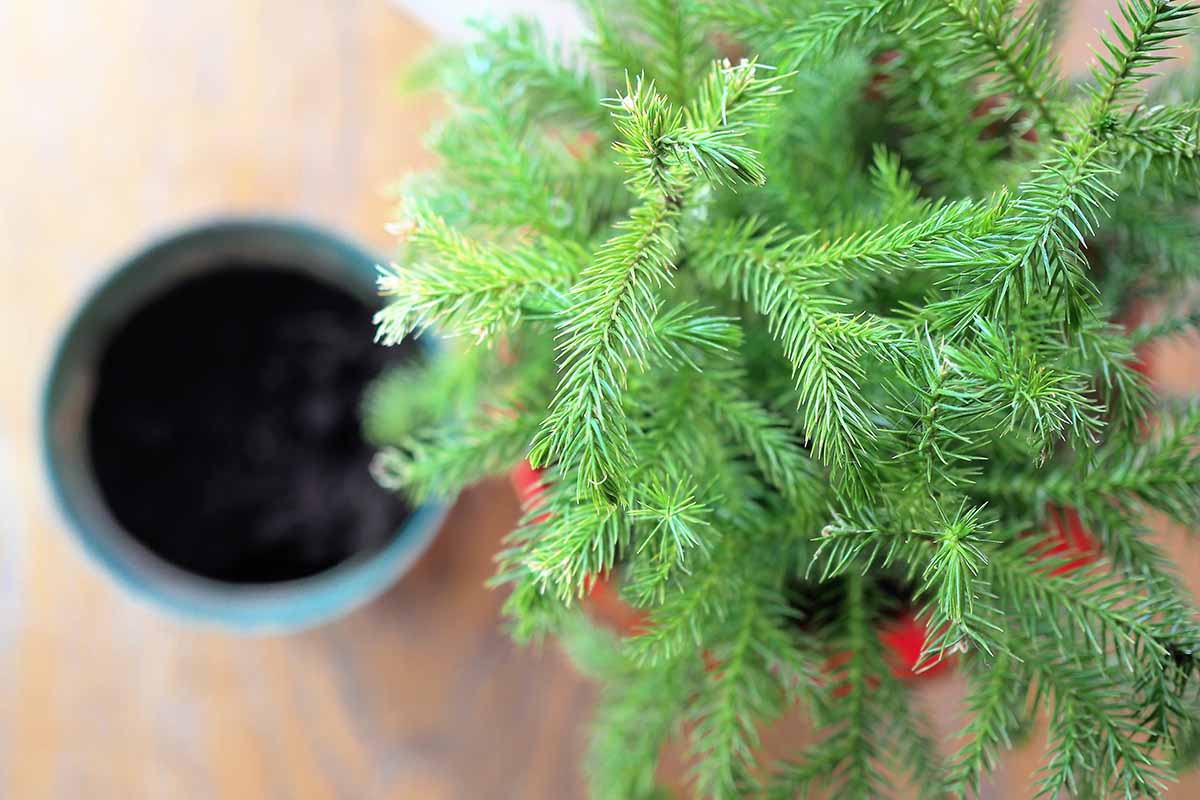Now you are contemplating the task of repotting this lovely living Christmas tree. Fear not, this is not such a grueling task – and you may even want to skip it! You’ll find out what I mean shortly. We link to vendors to help you find relevant products. If you buy from one of our links, we may earn a commission. I’ll also explain the best timing for the task, as well as the supplies you’ll need. And I’ll provide detailed guidelines for accomplishing this task. Here’s everything that’s coming up:
Why You Might Not Want to Repot
Repotting your living Christmas tree may seem like an element of standard care. Houseplants do grow while they’re inside our homes, after all, so they must need bigger containers from time to time – right? But there’s a reason why you might choose to skip this routine houseplant maintenance task, or at least do it very infrequently. As many seasoned Norfolk Island pine owners know, these coniferous trees can eventually outgrow our homes. While they aren’t actually pines, they are, indeed, trees. These are trees which can grow to be one to two hundred feet tall when planted outdoors! One way we can keep these conifers from outgrowing our homes too quickly is to limit the frequency of repotting. Gerard Klingman, retired horticulturist at the University of Arkansas Agricultural Extension, explains that by limiting the container size of this houseplant, we can restrict its root growth and can keep the conifer at a more manageable size for our households. If this sounds strange to you, consider that Norfolk Island pines can be used to create beautiful bonsai. This is a technique which drastically restricts the conifers’ roots, allowing us to keep them as miniatures instead of naturally maturing, towering trees. If keeping this plant at a more manageable size by restricting its root growth sounds like a brilliant idea, I recommend you only repot when the plant is drying out too quickly between waterings – and even then, you might be able to find a better solution. Keep reading to learn more.
When to Refresh Your Houseplant’s Soil
If you’re hoping to keep your living Christmas tree at an indoor-friendly size, you might still want to consider refreshing the plant’s soil every couple of years, but returning the conifer to the same pot. Soil can break down and become compacted over time, so an occasional freshening up can help keep your specimen healthy, and its roots well-aerated. Another highly recommended time to switch out your living Christmas tree’s soil is when your plant has experienced root rot, a condition that tends to arise from either poor drainage, overwatering, or some other factor that leads to soggy roots. In the case of root rot, you should inspect your plant’s roots and trim away any that are dead or rotting. Then replace the old soil with fresh growing medium, and transfer to a pot that is well-sized for the roots of your tree – this may mean moving your houseplant to a smaller container if an oversized pot was a factor that led to rot. Finally, if your tree is drying out too quickly between waterings, and the reason seems to be a growing medium that doesn’t have enough water retention, consider keeping the same sized pot but switch to a growing medium with better water retention. A note on this point – soil that is well-suited to one climate may not be ideal in another, so take your indoor temperature and relative humidity into account when choosing a soil mix.
When to Move to a Larger Container
Have high ceilings? If, on the other hand, you aren’t concerned about restricting your houseplant’s growth, you can transfer your living Christmas tree to a larger container every year or two. Keep in mind that it’s best to transplant when your specimen is in a period of active growth, in spring or summer. Doing so will permit your houseplant’s roots to grow into their newly expanded soil home at the ideal time.
Choosing a Container
If you’re repotting your houseplant because the growing medium has insufficient drainage, or because your plant has root rot, you can reuse the same sized container – or a smaller one, if necessary. That means it’s a good idea to choose a growing medium that has some sand in it for your houseplant. This sand isn’t just intended to make the plant feel at home symbolically. It will help to provide good drainage as well as stabilizing the tree in its container, helping it remain firmly upright. Soil Mender 109 Potting Mix Soil Mender’s 109 Potting Mix is my preferred growing medium for these conifers. This peat-free mix contains coconut coir, perlite, pine bark fines, and compost, as well as sand, giving the medium both good drainage and excellent water retention. You can purchase Soil Mender’s 109 Potting Mix at Arbico Organics. If you’re dealing with root rot and reusing the exact same container, make sure to sterilize it first. Washing the container with warm, soapy water and then wiping it down thoroughly with hydrogen peroxide will help to take care of any bacteria or fungi lingering on the container’s surfaces. On the other hand, if your specimen is healthy, you can skip the sterilization step if repotting in the same container. When transferring your plant to a larger container, choose one that is only one size larger. This will allow a bit more room without promoting soggy roots. Clean and sanitize it before use. Making sure the pot has drainage holes is just as important as picking an appropriately-sized container – this will help to prevent the dreaded root rot. If you have a decorative cachepot that you love but which has no drainage holes, place the houseplant first in a plastic or terra cotta container with drainage holes, and then set it inside the decorative pot. Are you wondering if you should use terra cotta or plastic? If you live in an arid climate or are a bit absentminded about watering, pick plastic, which will retain moisture longer. On the other hand, if you are the type of plant parent who tends to overwater, you might try terra cotta. It will allow moisture to evaporate more quickly, helping to make up for your overzealousness with the watering can. (Hey, no judgement, it’s just about knowing one’s weaknesses and adjusting accordingly!)
How to Repot
When it’s finally time to repot, gather your supplies first. You’ll need some growing medium as well as a new container if you are transferring your living Christmas tree to one that is larger, smaller, or better-draining. Once you have your supplies gathered up, start by gently tipping the plant out of its current container. If this proves to be harder than it sounds, pull (gently!) on the houseplant at the base of the trunk rather than grabbing it by its branches. Once you have extricated your houseplant, try to loosen up the roots of the plant next. If your conifer is rootbound, this may require a bit more work. For tightly bound roots, rub your hand along the edges of the root ball until the roots start to loosen up and are sticking out. On the other hand if your old soil mix was very chunky and loose, the roots may easily come completely free of the old soil. If the roots are healthy and have a fair bit of soil left around them, try loosening a bit of the soil out so that you can mix it in with your new soil. This will help water transfer between the two soil mediums – you’re creating a bridge between the old and the new. However, if you are repotting because of root rot, try to remove as much of the old soil as possible. Now, place a little of your new soil in the bottom of the container and situate your plant. Make sure the tree’s crown is about half an inch (for smaller specimens) to an inch (for medium-sized specimens) to two inches (for larger specimens) below the rim of the container. Once your houseplant is well-situated, fill the container in with your growing medium. Carefully avoid burying the crown of the tree in potting soil – keep it at the same level in the soil as it was growing before, unless it was planted too deeply. If your plant looks like it’s either too deep or too high in the container, adjust the amount of soil beneath the root ball and reposition it. Leaving half an inch to two inches of space (depending on the size of your container) between the surface of the soil and the rim of the container will help ensure that you can water without splattering soil over the edge. Tap the bottom of your newly transferred conifer lightly on your work surface to settle the soil in, and add more growing medium if needed. Water your plant in and return it to its usual location. Voila, you’re done! And if you want to learn more about growing and caring for this festive houseplant, be sure to read our complete guide to growing and caring for Norfolk Island pines. Are you rethinking your decision to repot your conifer in order to restrict the growth of your houseplant? Or are you on board for a giant living Christmas tree that will raise its branches right up to the top of your cathedral ceiling? Let us know in the comments section below. And for more information about growing Norfolk Island pine trees, have a read of these guides next:
How to Propagate Norfolk Island PineTips for Watering Norfolk Island Pine Trees
